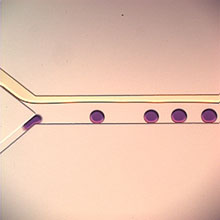Researchers have developed a way to create uniformly sized cell membranes, small cellular packages that can be used like tiny terrariums to study the inner workings of the cell and even create new molecules.

Sandro Matosevic and Brian Paegel of the Scripps Research Institute in Jupiter, Florida, have developed a chip-based method that creates uniformly sized vesicles in assembly-line fashion. Sized between 20 and 70 micrometers in diameter, the vesicles are large enough to be loaded with DNA and the biochemical machinery to act as synthetic cells. The synthetic packaging will help researchers study the proteins in cell membranes, which play important roles as gatekeepers of the cell. Many drugs, for example, act on these membrane proteins or otherwise use them to get inside cells in order to do their job.
Paegel and his colleagues want to use the system to create membrane proteins with new and useful functions. “From an evolutionary standpoint, they’re just this really juicy class of molecules to target for new functions, because they do all this interesting chemistry,” Paegel says. These molecules have traditionally been difficult to work with because they require a lipid bilayer—the double layer of fatty molecules that makes up the cell membrane—in order to function. A synthetic cell membrane, like the type created in the study, allows scientists to house a single gene as well as the other biochemical components for synthesizing that membrane protein.
Don’t settle for half the story.
Get paywall-free access to technology news for the here and now.